Basic Care of Books – Canadian Conservation Institute (CCI) Notes 11/7
Disclaimer
The information in this document is based on the current understanding of the issues presented. It does not necessarily apply in all situations, nor do any represented activities ensure complete protection as described. Although reasonable efforts have been made to ensure that the information is accurate and up to date, the publisher, Canadian Conservation Institute (CCI), does not provide any guarantee with respect to this information, nor does it assume any liability for any loss, claim or demand arising directly or indirectly from any use of or reliance upon the information. CCI does not endorse or make any representations about any products, services or materials detailed in this document or on external websites referenced in this document; these products, services or materials are, therefore, used at your own risk.
Introduction
Books are common objects in both public and personal collections. This CCI Note is an introduction to the care of books, with a focus on handling books of significance to their owners. Unlike many objects held in heritage collections, books are typically objects of use and are not meant merely to be displayed. As structural objects that are almost always designed to move, they are subject to stress and damage related to that use. Damage can occur due to the quality of the materials, the strength or weakness of the binding, the type of handling and the environmental conditions.
Suggestions for further reading and a list of preservation suppliers are included at the end of this Note. If any significant intervention is required for a historic bookbinding, consult a professional conservator.
Background
The codex format of the book dates to the 2nd century AD. Prior to its introduction, texts were written on scrolls and wax tablets. There are many different types of books beyond the codex format across multiple traditions, including accordion books and threaded-leaf manuscripts. The focus of this Note is the codex format, although the general recommendations for environmental conditions and handling are relevant to other book formats.
Prior to the 19th century, all books were handbound by bookbinders. Books were either handwritten or printed using movable lead type. The materials of the book, such as leather, parchment, adhesives, pigments, textiles and paper, came out of specific craft industries dedicated to those materials. Traditions in bookbinding materials and techniques varied greatly by region and historical period.
With the advent of the machine age in the 19th century, the processes for bookbinding became increasingly mechanized. Printing, papermaking and binding methods all changed with the Industrial Revolution, and they continue to evolve with changes in technology. These changes have an impact on the materials that make up a book and the likelihood of a book’s survival over time.
Materials
Books are composite objects that can include a wide range of materials such as leather, parchment, paper, textiles, wood, adhesives, binding boards, metals and plastics. Books can house photographs, botanical specimens and mixed scrapbook-type collections. All these materials will react differently and at different speeds to changes in environmental conditions. Some materials, such as parchment, are more susceptible to damage with fluctuations in relative humidity (RH). Media used for written content and illustrations can include printing ink, iron gall ink, carbon-based ink, laser-printed ink and many different colourants.
Vegetable-tanned leather
Vegetable-tanned leathers such as goatskin, calfskin, sheepskin and pigskin are the principal leathers used for bookbindings. These leathers are favoured for their appearance, stability and durability. Chrome-tanned leather was rarely used for binding; however, it was and still is typically used for clothing and furniture.
As leather degrades, it loses mechanical strength and can become embrittled, crazed or friable (powdery). Red rot, an extreme form of powdery reddish-brown leather, is caused not by low humidity or natural aging but by the action of acids (for example, sulfuric acid) found in air pollutants. Never carry out standard treatments on powdery leather or on leather that has red rot. Seek advice or treatment from a professional conservator for this condition. For more information, consult CCI Note 8/2 Care of Alum, Vegetable, and Mineral-tanned Leather.
Rough calf or suede
Volumes bound in rough calf or suede use the flesh side of the leather, sometimes referred to as the nap side (the underside of the leather that is not stained, polished or otherwise treated to give it its final appearance). These leathers are normally found on bindings done in the account, ledger or letter-book styles.
Parchment
Parchment is a form of animal skin that is untanned. The chemical process consists of soaking the skin in lime, then stretching and scraping it before allowing it to dry under tension. This creates an off-white stiff material. Parchment is used as the general term for material made with any animal skin; the term vellum refers specifically to the material made from calfskin. Both materials were frequently used for limp-vellum or limp-parchment bindings and hardcover parchment bindings. Parchment or vellum was used for textblocks and archival materials, such as legal charters, prior to the introduction of paper. It continued to be used well into the 19th century for its longevity. Parchment should not become wet, as it is prone to cockling and distortion, and degraded parchments can gelatinize irreversibly.
Alum-tawed skin
Alum-tawed skin has been treated with aluminum salts and other materials but has not been tanned. The chemical and physical process of making the skin produces a material that has a high degree of flexibility and that is white or off-white in colour. It is a highly durable material that is still used in book conservation, but it is greatly susceptible to damage by water or moisture.
Cloth
Many books in Canadian libraries are bound in various types of cloth. Common commercial materials include buckram and Rexine in a variety of colours, thicknesses and textures. Historically, bindings have also been bound in calico, velvet and silk. Textiles were also often used as layperson repair materials. Water can easily damage many textiles, particularly since fillers, such as starch, have been historically added to bookbinding cloth. From the early 20th century onwards, bookbinding cloth has sometimes been treated or manufactured with acrylics or other plastics to provide an impervious coating to moisture.
Paper
Many books are covered in paper. This broad group can include everything from pamphlet or chapbook bindings, consisting of a few leaves of printed matter, historic paper case bindings, paper book jackets and the covers of modern paperback books.
Other materials
In rare cases, bookbinders have used unusual covering materials such as tortoiseshell, ivory and bone. Sometimes, they used cellulose nitrate and other plastics to imitate these materials. Imitation or synthetic leather has also been used to cover bookbindings. Typically, these are plastic or a laminate of plastic and cloth. Plastics will also degrade over time.
Environment
Relative humidity and temperature
Most materials used in books are hygroscopic, in that they are reactive to water and will react to fluctuations in RH. Books do best in a climate that is neither too dry, which can negatively impact materials such as leather or parchment, nor too humid, which can lead to physical distortion and mould. RH cycling can cause significant damage. Do not subject leather or parchment bindings to RH extremes. Cold exterior conditions combined with dry central heating can reduce the RH inside a building to less than 30% and cause loss of moisture and embrittlement of leather. High humidity (over 75% RH) and inadequate air circulation encourage mould growth. Locally elevated temperatures (such as hot display cases or storage near a radiator) can desiccate leather. The ideal climate conditions for leather are a stable RH in the range of 45% to 55% and a stable human comfort temperature of 18°C to 22°C. It is not always possible to achieve ideal conditions, and a risk management approach will best serve collections overall. (Consult Agent of deterioration: incorrect relative humidity – Control in terms of overall strategies and target values.)
Illumination
Avoid storing or displaying books under spotlights, in full sunlight or in artificial light, all of which can cause discolouration, desiccation and photochemical degradation. If you are unable to avoid direct sunlight, use UV film or blinds to limit exposure. Light fades or darkens some dyes (colourants used to tone a wide variety of book-covering materials such as leather, cloth and paper) and increases the deterioration of materials. Because the damage due to light is cumulative and irreversible, limit exposure time whenever possible. This can be done even in simple ways, such as turning on lights in storage areas only when the room is in use. Display and store books at a maximum light level of 150 lux with an ultraviolet light content of less than 75 µW/lm. Extremely light-sensitive materials, such as illuminated manuscripts, should be exposed to a light level of less than 50 lux with an ultraviolet content of less than 75 µW/lm.
Storage
Ideally, store books on baked enamel steel shelving. Uncoated wooden shelving is not recommended as a best practice because all wood products contain volatile acids that can be released from uncoated surfaces. That said, coated shelving that has been properly cured (consult Technical Bulletin 23 Guidelines for Humidity and Temperature for Canadian Archives) can be used if necessary. Dubus et al. (2014) conducted research that indicated books are at a relatively low risk of damage from historic wood shelving due to the high air exchange and minimal ability for volatile organic compounds to penetrate book edges.
Books should not be stored in areas such as attics or basements if this can be avoided. Because of the RH and temperature restrictions mentioned previously, do not store volumes over radiators or furnace pipes, in damp basements or near plumbing pipes. Do not place books on the top of a shelving unit, which leaves them susceptible to damage during a sprinkler system activation. Place books vertically, supporting them with bookends. To facilitate removal, do not pack books too tightly. Place library call numbers (shelf markings) on acid-free paper and insert them into books; do not apply them directly onto book spines.
If feasible, store similarly sized books together and avoid storing books directly against the back of the bookshelf, so as to aid in removal as well as reduce low airflow zones (microclimates). Create a barrier for bookshelves with abrasive rails (the ones for adjustable shelving). Store large volumes flat and keep stacking to a minimum. Stacking should be done spine to foredge.
You can mitigate the effects of fluctuations in environmental conditions with the use of proper storage. A simple box or enclosure made from stable materials can help buffer a book from shifts in RH, protect it from light damage and retain any loose or damaged parts of the binding. A proper housing can also protect a book in case of an unexpected disaster, such as a flood or fire. Specially constructed slip cases and flat boxes (solander boxes) are excellent for storing rare and damaged volumes. (Consult CCI Note 11/1 Making Enclosures for Books and Paper Objects.)
Handling
Improper handling is a major cause of damage to bindings. Most books are not designed to open flat and, therefore, should not be opened to 180 degrees. When handling a book, the reader should respect the limitations of the binding. In the absence of foam book wedges, use a simple improvised cradle made from a rolled towel to support a book on a reading table. It is particularly important to support the joints of the book when handling it and to be conscious of the book’s opening characteristics.
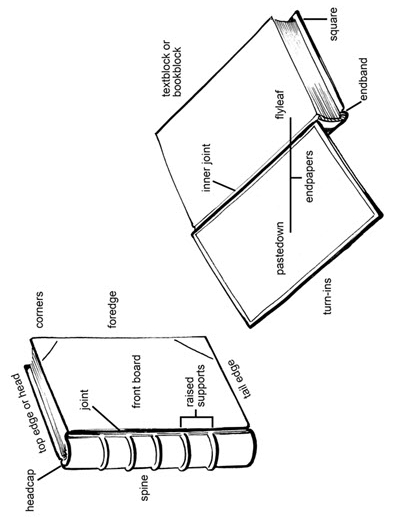
© Government of Canada, Canadian Conservation Institute. 131598-0001
Figure 1. A diagram showing the parts of a book.
Here are some handling suggestions for books:
- When removing books from a shelf, reach over and push the book forward from the foredge, then grasp the boards at either side of the spine, if possible. If you are unable to do this, push the neighbouring books on either side slightly back to expose the volume for removal. When removing books from shelves, grasp the book firmly around the centre of the spine and ease the volume from the shelf.
- Do not hook your finger over the headcap (the leather covering at the head and tail of a book, formed by turning the leather on the spine over the head and tail and shaping it) to remove the book from the shelf, as this will damage the spine.
- Use both hands for large and heavy volumes. If you are removing a volume that is beneath another, remove the top volume first.
- If books are removed from a shelf for processing, cleaning or conservation treatment, transport them on a trolley or in a cardboard box.
- It is recommended to handle books with clean dry hands or while wearing thin disposable nitrile or latex gloves. Gloves should be worn when working with books that contain photographic materials or metals. Thick cotton gloves are not recommended for handling rare books because they can damage degraded leather or paper.
- Be careful with any jewellery or watches; remove them, if necessary.
- Clear all surfaces of anything that could be damaging to the book.
- Avoid sliding books around on shelves or tables to minimize leather damage.
- Use an appropriate support, as necessary, to facilitate opening the book.
Digitization and facsimiles
Libraries or archives will sometimes make a digital or physical copy to limit the handling of a rare or important book or to facilitate access. In the past, this was often done using a photocopier or scanner, but it is now also possible to photograph pages using a digital camera. Photographing the pages of a book can be a gentler approach to copying the contents than using a photocopier, which can stress the binding and subject the pages to excessive light. When photographing books, an improvised book cradle and light weights can help support the binding. A camera stand can help hold the camera at a consistent distance from the book. When making a digital copy for a library or archive collection, it is important to consult the relevant copyright legislation prior to digitization. For damaged books, it may be preferable to hire a professional digitization company that specializes in handling and photographing rare books.
Maintenance and care
General maintenance and good care practices can improve the life expectancy of a book. Good housekeeping is essential to the care of books. It is recommended to inspect for dust and to dust shelving at least every twelve months. Deal with signs of mould or biological attack immediately (consult Technical Bulletin 12 Controlling Museum Fungal Problems, Technical Bulletin 13 Controlling Vertebrate Pests in Museums, Technical Bulletin 15 Solving Museum Insect Problems: Chemical Control and CCI Note 3/1 Preventing Infestations: Control Strategies and Detection Methods).
Cleaning
Cleaning can visually improve the appearance of soiled bookbindings while removing dust and dirt that can attract pests and trap humidity. Any cleaning steps must be done slowly to ensure that no parts of the book are damaged. Always clean in a well-ventilated area. If you are working with very dusty materials, you may wish to wear a dust mask. Do not attempt to clean mould from books without the appropriate precautions, as detailed in Technical Bulletin 26 Mould Prevention and Collection Recovery: Guidelines for Heritage Collections, which outlines appropriate steps for mould remediation. Mould presents a significant health risk to the user.
Bindings can be gently cleaned on the outside along the covering material and edges. Be cautious, however, as dry cleaning can damage leather that is red rotted or fragile. First, thoroughly dust the binding using a dry, lint-free cloth or a soft-bristled brush such as a shaving brush or an artist’s paint brush. It is recommended to use a soft natural fibre brush, such as goat hair or horsehair, and to avoid synthetic brushes, which cause static. To keep the binding clean, brush dust away from the spine of the book (Figure 2).
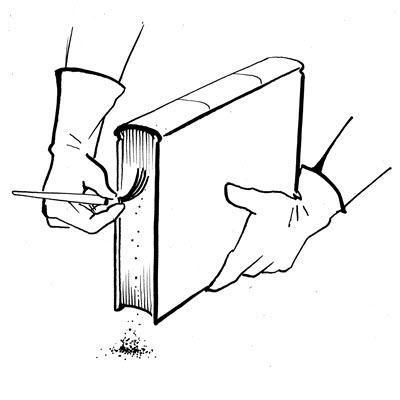
© Government of Canada, Canadian Conservation Institute. 131598-0003
Figure 2. Brush dust away from the binding.
A vacuum cleaner can also be used to remove dust (Figure 3). It is better to use an adjustable suction museum vacuum to remove dust than a household vacuum, if possible. The vacuum should be used in conjunction with a brush, or it should have a special nozzle rather than the standard brushes. If necessary, attach a cheesecloth or fibreglass screen over the throat of the brush attachment to prevent loose pieces of paper or leather from detaching and being sucked into the vacuum cleaner (Figure 4).
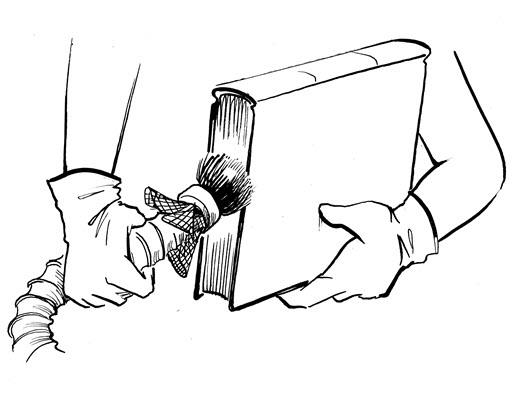
© Government of Canada, Canadian Conservation Institute. 131598-0004
Figure 3. Removing dust with a vacuum cleaner brush.
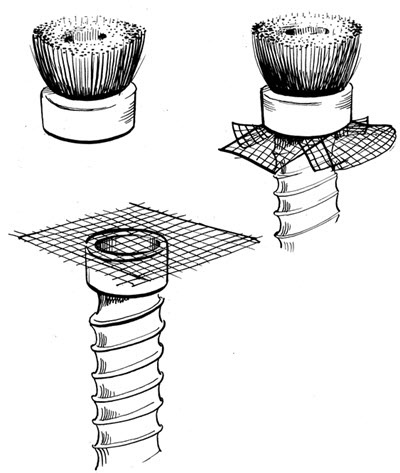
© Government of Canada, Canadian Conservation Institute. 131598-0005
Figure 4. Place a protective screen over the vacuum cleaner hose.
You may remove slightly ingrained dirt from stable cloth and paper bindings in good condition by gently working over the surface with smoke sponges, cosmetic sponges or white vinyl erasers (Magic Rub). Meticulously remove all particles of eraser with a brush and vacuum cleaner. As with any cleaning method, first conduct a small test on an unobtrusive area. Do not clean rough calf or suede leather with erasers because the residue is difficult to remove.
To avoid abrasion damage, use lint-free cloths only on robust surfaces such as modern cloth bindings (not leather or parchment). It is not recommended to use moisture to clean bindings because this could disturb, darken or remove the surface or dyes from the covering material of the book. Very soiled bookbindings should be referred to a professional conservator for assessment.
A note on leather dressings
Leather dressings, though commonly used in the past, are not recommended as a treatment for leather. These dressings, which consist of oils, waxes or oil emulsions, were applied in an attempt to make the leather softer and more flexible. However, the application of additional oils from a dressing may in fact cause further stiffening by dehydrating the leather (Van Soest et al. 1984). Furthermore, many oils and fats used in leather dressings lubricate in the short term but oxidize over time, resulting in additional stiffening of the leather. Applying a leather dressing creates many other problems, including the risk of attracting dust or insects, darkening the leather’s surface or staining surrounding materials. In the past, leather bindings may have also been sealed with a varnish coating to protect the surface, creating an impervious film. Any leather dressing applied over such a film would not soak into the leather binding and would increase the risk of waxy buildup on the surface of the leather.
Damaged books
There are numerous types of possible damage to books, including broken joints, damaged boards, split endpapers, tears and acidic paper. In many cases, it may be possible to carry out minor repairs or to store damaged books in acid-free enclosures.
Broken joints
Many books deteriorate, especially leather-bound volumes, and the boards separate at the joints. Do not repair these joints with a pressure-sensitive tape such as carpet tape, duct tape, masking tape, packing tape or generic adhesive tape. These tapes leave permanent stains and are almost impossible to remove without damaging the surface of the material. Repair materials meant for circulating library collections are not appropriate for historic books of any significance. Many commercially available products for board reattachment and book repair can be irreversible and cause further damage to historic materials.
If you are unable to send a book for conservation, a solution in the interim can be to tie the book using cotton twill tape (Figure 5). This will keep the boards together with the textblock. The bow should be tied on the foredge, and the book can then be returned to the shelf. Alternatively, you can purchase a box from an archival supplier or make an acid-free box in which to store the book (consult CCI Note 11/1 Making Enclosures for Books and Paper Objects).
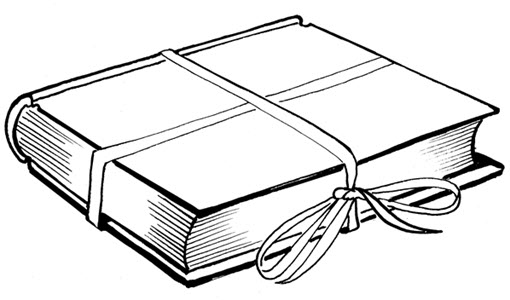
© Government of Canada, Canadian Conservation Institute. 131598-0006
Figure 5. Illustration of a book that has been tied with cotton twill tape.
Paper tears
Ideally, all tears should be repaired using Japanese tissue paper and wheat starch paste. Ask a qualified book or paper conservator to carry out these repairs. Place detached pieces in archival envelopes while waiting for repairs.
Never use generic tape to repair paper or joints in a book unless that book is considered disposable. The tape will yellow and deteriorate over time, damaging the book.
If temporary repairs are necessary for a book in circulation or in a personal collection, use commercial archival tapes cautiously. Most of these tapes contain synthetic adhesives of limited reversibility; therefore, it may not be possible to remove the tape later without causing substantial damage to the object. These tapes are not recommended for use on historic materials. Please note that tapes are commercial products and, as such, the manufacturers can alter them chemically without notice and without changing the product names.
Suppliers
- Carr McLean (Canada)
- George Hill & Co. (Canada)
- Talas (USA)
- University Products (USA)
- Conservation by Design (UK)
Bibliography
Dubus, M., et al. “Composés organiques volatils émis par les boîtes d’archives anciennes en bois” (PDF format) (in French only). Support Tracé 14 (2014), pp. 68–76.
Van Soest, H.A.B., T. Stambolov and P.B. Hallebeek. “Conservation of Leather.” Studies in Conservation 29,1 (1984), pp. 21–31.
Further reading
Ball, D. Victorian Publishers’ Bindings. London, UK: Library Association Publishing, 1985.
British Library. Preservation guides, n.d.
Bibliothèque et Archives nationales du Québec. Fiches techniques. Montréal, Quebec: Bibliothèque et Archives nationales du Québec, n.d.
Bibliothèque nationale de France. Ressources en conservation du patrimoine écrit et numérique : Fiches techniques (in French only). Paris, France: Bibliothèque nationale de France, n.d.
Canadian Conservation Institute. Making Enclosures for Books and Paper Objects. CCI Notes 11/1. Ottawa, ON: Canadian Conservation Institute, 1996.
Canadian Conservation Institute. Storing Works on Paper. CCI Notes 11/2. Ottawa, ON: Canadian Conservation Institute, 1995.
Cowan, J., and S. Guild. Dry Methods for Surface Cleaning of Paper. Technical Bulletin 11. Ottawa, ON: Canadian Conservation Institute, 2001.
Grattan, D., and S. Michalski. Environmental guidelines for museums. Ottawa, ON: Canadian Conservation Institute, 2017.
Guild, S., M. MacDonald and T. Strang. Mould Prevention and Collection Recovery: Guidelines for Heritage Collections, revised. Technical Bulletin 26. Ottawa, ON: Canadian Conservation Institute, 2020.
Hadgraft, N., and K. Swift, eds. Conservation and Preservation in Small Libraries. Cambridge, UK: Parker Library Publications, 1994.
Hannington, D., and C. McNair. Display Methods for Books, revised. CCI Notes 11/8. Ottawa, ON: Canadian Conservation Institute, 2022.
Kite, M., and R. Thomson, eds. Conservation of Leather and Related Materials. Boston, MA: Elsevier Butterworth-Heinemann, 2006.
Lock, M. Bookbinding Materials and Techniques 1700–1920. Toronto, ON: Canadian Bookbinders and Book Artists Guild, 2003.
Michalski, S. Guidelines for Humidity and Temperature for Canadian Archives. Technical Bulletin 23. Ottawa, ON: Canadian Conservation Institute, 2000.
Middleton, B. A History of English Craft Bookbinding Technique. New Castle, DE, and London, UK: Oak Knoll Press and the British Library, 1996.
Northeast Document Conservation Center. NEDCC Preservation Leaflets, n.d.
Pearson, D. English Bookbinding Styles 1450–1800: A Handbook. London, UK, and New Castle, DE: The British Library and Oak Knoll Press, 2005.
Roberts, M.T., and D. Etherington. Bookbinding and the Conservation of Books: A Dictionary of Descriptive Terminology, n.d.
Strang, T., and R. Kigawa. Combatting Pests of Cultural Property. Technical Bulletin 29. Ottawa, ON: Canadian Conservation Institute, 2009.
Szirmai, J.A. The Archaeology of Medieval Bookbinding. Aldershot, UK: Ashgate, 1999.
Tétreault, J. Coatings for Display and Storage in Museums. Technical Bulletin 21. Ottawa, ON: Canadian Conservation Institute, 1999.
Walrave, O., ed. La restauration à la Bibliothèque nationale de France. Paris, France: Bibliothèque nationale de France, 2003.
By David Hannington
Revised by Christine McNair in 2022
Originally published in 1995
© Government of Canada, Canadian Conservation Institute, 2022
Cat. No.: NM95-57/11-7-2022E-PDF
ISSN 1928-1455
ISBN 978-0-660-46182-3